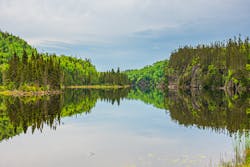The Canadian government has awarded Whitesand First Nation’s Sagatay Co-Generation $35 million to develop a combined heat and power (CHP) plant and connect it to a local diesel microgrid.
The 6.5-MW facility will use local wood waste to produce electricity for Whitesand First Nation — which owns Sagatay Co-Generation — as well as the surrounding communities of Armstrong and Collins, Ontario.
Jonathan Wilkinson, Canada’s natural resources minister, said the “federal investment is helping to power low-carbon solutions in the region while supporting Indigenous leadership.”
A long-term vision of energy independence
Located about 150 miles north of Thunder Bay, Ontario, they first proposed this biomass cogeneration facility in 1992.
Gustafson went on to say that “despite the many barriers we have faced through the years, we did not give up and today our vision of a sustainable future through the use of our local forest is at hand.”
Reducing emissions and energy costs
Whitesand First Nation is currently supported by a diesel-powered microgrid, which consumed over 340,000 gallons of fuel in 2022.
The CHP project will reduce the amount of diesel fuel needed for heating and electricity across the three communities, which will lower energy costs and emissions, as well as improve air quality.
The project will show other remote and indigenous communities how biomass heat and power can be efficient and cost effective.
Supporting the local economy
Both Whitesand leadership and the Canadian government say that the CHP facility will encourage the economic development of the remote indigenous community by providing new jobs and opportunities in the local bioeconomy.
Patty Hajdu, Canada’s indigenous services minister and a member of parliament, said the project would help the entire region and that “this is economic reconciliation in action.”
Whitesand will be home to the Bio-Economy Center, which will include a new wood pellet plant and a wood merchandising yard. Both will be heated and powered by the new CHP plant and microgrid.
Indigenous communities benefit from microgrids
Often remote and off-grid, many indigenous communities have turned to microgrids and renewable energy to ensure reliable power for their members. In 2019, Gull Bay First Nation commissioned a hybrid solar plus storage microgrid in partnership with Ontario Power Generation. In 2021, the Xeni Gwet’in First Nation in British Columbia completed their own renewable energy microgrid.
Track news about First Nation microgrids. Subscribe to the free Microgrid Knowledge newsletter.








